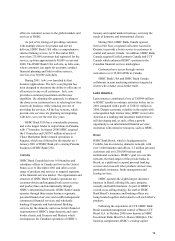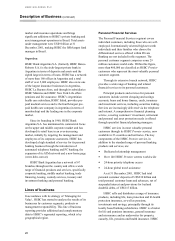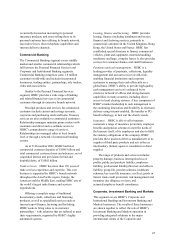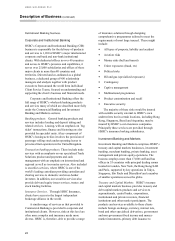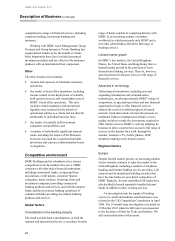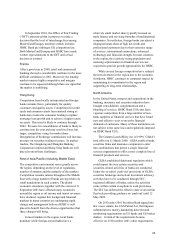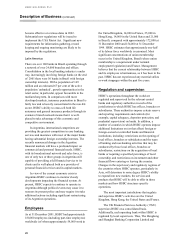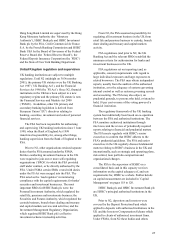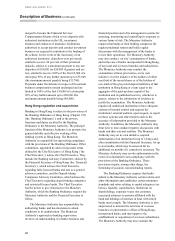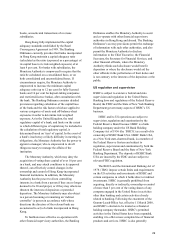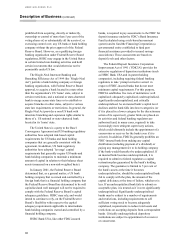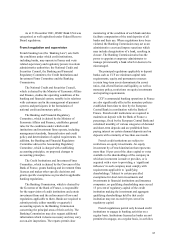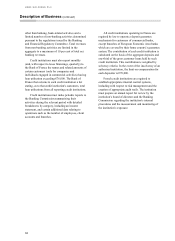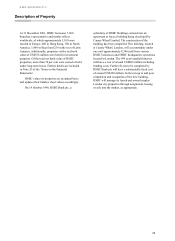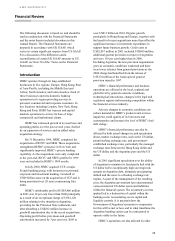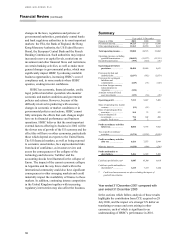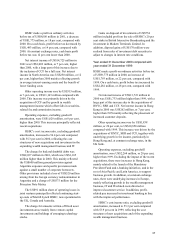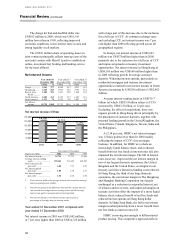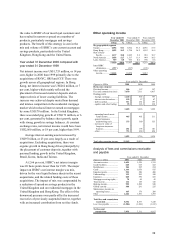HSBC 2001 Annual Report Download - page 31
Download and view the complete annual report
Please find page 31 of the 2001 HSBC annual report below. You can navigate through the pages in the report by either clicking on the pages listed below, or by using the keyword search tool below to find specific information within the annual report.29
books, accounts and transactions of overseas
subsidiaries.
Hong Kong fully implemented the capital
adequacy standards established by the Basel
Convergence Agreement in 1989. The Banking
Ordinance currently provides that banks incorporated
in Hong Kong maintain a capital adequacy ratio
(calculated as the ratio (expressed as a percentage) of
its capital base to its risk-weighted exposure) of at
least 8 per cent. For banks with subsidiaries, the
Monetary Authority is empowered to require that the
ratio be calculated on a consolidated basis, or on
both consolidated and unconsolidated bases. If
circumstances require, the Monetary Authority is
empowered to increase the minimum capital
adequacy ratio (up to 12 per cent for fully-licensed
banks and 16 per cent for deposit-taking companies
and restricted-licence banks), after consultation with
the bank. The Banking Ordinance contains detailed
provisions regarding calculation of the capital base
of the bank and the risk factors which are applied to
various categories of assets and off-balance-sheet
exposures in order to determine risk-weighted
exposure. As in the United Kingdom, the total
regulatory capital of a bank, and limits on the extent
to which different types of capital may be included in
the calculation of total regulatory capital, is
determined based on ‘tiers’ of capital. In the event of
a bank’s insolvency or likely difficulty in meeting its
obligations, the Monetary Authority has the power to
appoint a manager, who is empowered to do all
things necessary to manage the affairs of the
institution.
The Monetary Authority, which may deny the
acquisition of voting share capital of over 10 per cent
in a bank, and may attach conditions to its approval
thereof, can effectively control changes in the
ownership and control of Hong Kong-incorporated
financial institutions. In addition, the Monetary
Authority has the power to divest controlling
interests in a bank from a person if they are no longer
deemed to be fit and proper, or if they may otherwise
threaten the interests of depositors or potential
depositors. The Monetary Authority may also object
to a person becoming or remaining an ‘indirect
controller’ (a person in accordance with whose
directions the directors of the relevant bank are
accustomed to act) of a bank incorporated in Hong
Kong.
To facilitate more effective co-operation with
other financial supervisory authorities, the Banking
Ordinance enables the Monetary Authority to assist
and co-operate with other financial supervisory
authorities in Hong Kong and abroad. The Banking
Ordinance’ s secrecy provisions permit the exchange
of information with such other authorities, and also
permit the Monetary Authority to disclose
information to the Chief Executive, the Financial
Secretary, the Secretary for Financial Services, and
other financial officials, where the Monetary
Authority thinks such disclosure would benefit
depositors or where the disclosure would aid the
other officials in the performance of their duties and
is not contrary to the interests of the depositors or the
public.
US regulation and supervision
HSBC is subject to extensive federal and state
supervision and regulation in the United States.
Banking laws and regulations of the Federal Reserve
Board, the FDIC and the State of New York Banking
Department govern many aspects of HSBC’s US
business.
HSBC and its US operations are subject to
supervision, regulation and examination by the
Federal Reserve Board because HSBC is a bank
holding company under the US Bank Holding
Company Act of 1956 (the ‘BHCA’ ) as a result of its
ownership of HSBC Bank USA. HSBC Bank USA,
as a New York state-chartered bank, is a member of
the Federal Reserve System and subject to
regulation, supervision and examination by both the
Federal Reserve Board and the State of New York
Banking Department. The deposits of HSBC Bank
USA are insured by the FDIC and are subject to
relevant FDIC regulation.
The BHCA and the International Banking Act of
1978 (‘IBA’ ) impose certain limits and requirements
on the US activities and investments of HSBC and
certain companies in which it holds direct or indirect
investments. HSBC is generally prohibited from
acquiring, directly or indirectly, ownership or control
of more than 5 per cent of the voting shares of any
company engaged in the United States in activities
other than banking and certain activities closely
related to banking. Following the enactment of the
Gramm-Leach-Bliley Act, effective 11 March 2000,
and HSBC’s election to be treated as a financial
holding company thereunder, HSBC’s permitted
activities in the United States have been expanded,
enabling it to offer a more complete line of financial
products and services. HSBC is also generally


